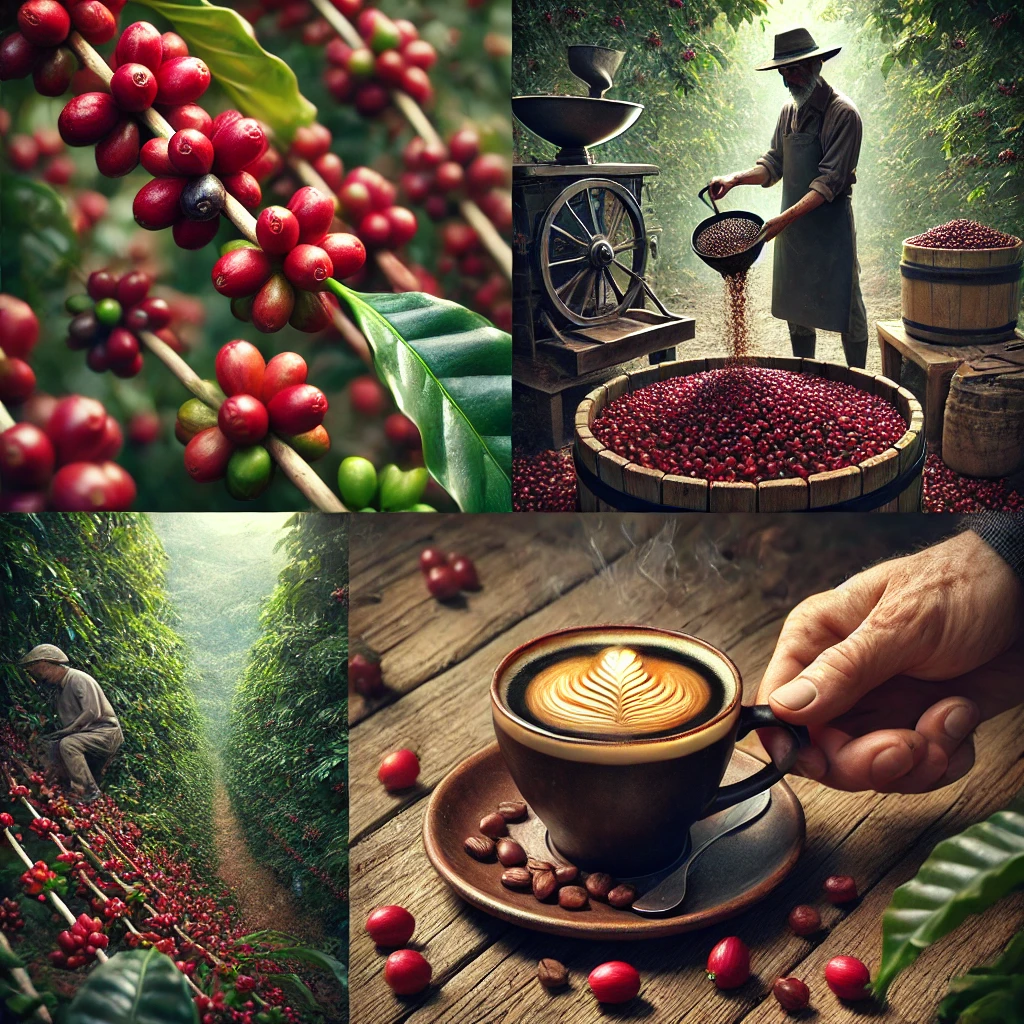Introduction:
Coffee isn’t just a drink; it’s a way of life for many of us. But have you ever stopped to think about how those tiny beans make their way from lush green farms into your favorite mug? From cultivation to brewing, the process of creating coffee is intricate and fascinating. Let’s break down this journey, from tree to cup, and discover the artistry behind your everyday brew.
1. Coffee Cultivation – Where It All Begins
Coffee’s story starts in the Coffee Belt, a region around the equator where optimal conditions—climate, altitude, and soil—come together to grow coffee beans. The two main species cultivated are Arabica and Robusta, each with unique flavor profiles and growing conditions.
- Arabica is prized for its smooth, complex flavors and is mostly grown in higher altitudes.
- Robusta, often used in espresso blends, is stronger, more resilient, and has a bolder flavor with more bitterness.
Sustainable practices are becoming increasingly popular, with many farmers adopting organic farming techniques to reduce environmental impact.
2. Harvesting Coffee – The Hands that Pick the Beans
Harvesting coffee requires precision and patience. Coffee cherries don’t ripen all at once, meaning the harvesting process varies between regions and farming methods.
- Selective harvesting involves hand-picking only the ripe cherries, which ensures high-quality beans but is labor-intensive.
- Strip harvesting, where all cherries are picked at once, is quicker but less selective.
This stage is critical, as the timing and method of harvesting directly impact the quality of the coffee.
3. Coffee Processing – From Cherry to Bean
Once harvested, the coffee cherries need to be processed to extract the beans. The processing method plays a major role in shaping the flavor of the coffee.
- Dry (natural) processing involves drying the whole cherries in the sun, resulting in a sweet, fruity flavor.
- Wet (washed) processing removes the cherry flesh before fermentation, creating a cleaner, brighter taste.
- Honey processing is a middle ground, leaving some of the cherry pulp on the bean, leading to a balanced sweetness and acidity.
Each method highlights different flavor notes in the final product.
4. Milling the Coffee – Getting the Beans Ready
Before coffee can be roasted, the beans need to be milled. This involves hulling, which removes the parchment layer around the bean, and polishing, which smooths out imperfections.
- Beans are then sorted and graded based on size and weight to ensure consistency.
- Proper storage is crucial to maintain the beans’ freshness before they are shipped off to roasters worldwide.
5. Roasting – The Transformation of Green Beans
Roasting is where green coffee beans transform into the aromatic, flavorful coffee we know and love. Different roast levels—light, medium, and dark—bring out different characteristics of the beans.
- Light roasts tend to have higher acidity and showcase the bean’s natural flavors.
- Medium roasts balance acidity and body, creating a rounded flavor.
- Dark roasts have bold, smoky flavors, with less acidity.
The Maillard reaction during roasting is what brings out the complex flavors in coffee. Small-batch roasting has gained popularity, allowing for greater precision and experimentation with flavors.
6. Grinding the Beans – Prepping for Brew
To make the perfect cup of coffee, it’s essential to grind the beans to the right size. The grind size depends on the brewing method:
- Espresso needs a fine grind for quick extraction.
- Drip coffee uses a medium grind for even brewing.
- French press requires a coarse grind to avoid over-extraction.
Grinding fresh beans right before brewing ensures maximum flavor and aroma.
7. Brewing – The Final Step from Bean to Cup
Now that the beans are roasted and ground, it’s time for the final step: brewing. The method you choose will greatly influence the flavor profile of your coffee.
- Espresso is a quick, pressurized method that results in a rich, concentrated shot.
- Drip coffee is the most common method, producing a clean, smooth cup.
- French press allows for a fuller-bodied brew by steeping the coffee in hot water.
- Cold brew offers a milder, less acidic cup by steeping coffee grounds in cold water for hours.
Remember, factors like water temperature, brewing time, and water quality all play crucial roles in achieving the perfect brew.
FAQs
- How long does it take for a coffee plant to produce beans?
Coffee plants typically take 3 to 4 years to produce their first crop of beans. - What’s the difference between Arabica and Robusta coffee?
Arabica is smoother and sweeter with hints of fruit and sugar, while Robusta has a stronger, more bitter, and earthy flavor. - What’s the best way to store coffee beans?
Coffee beans should be stored in an airtight container away from light, heat, and moisture to maintain freshness. - Why is freshly ground coffee better?
Freshly ground coffee preserves the bean’s natural oils and aromas, offering a more flavorful and aromatic cup than pre-ground coffee.
Wrapping Up
From the moment those coffee cherries are picked to the second you take that first sip, there’s a world of labor and artistry behind every cup. Coffee’s journey from tree to cup is a fascinating process that involves careful cultivation, skilled processing, and precision brewing. So next time you enjoy your morning brew, take a moment to appreciate the incredible journey your coffee has taken!

